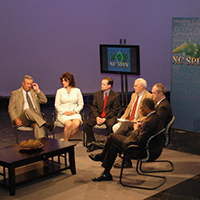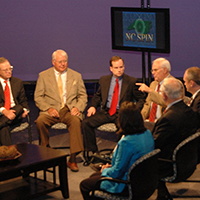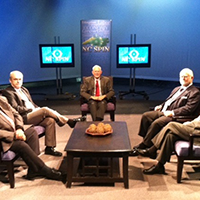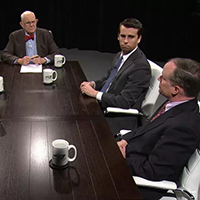Dealing with our dark side of history
Published April 15, 2015
Editorial by Wilmington Star-News, April 13, 2015.
A bunch of legislators up in Raleigh want to put a statue of the Rev. Billy Graham up in the Capitol in Washington, D.C.
On the surface, this seems a pretty good idea. Graham updated evangelism to the television age. More importantly, he desegregated his audiences in the Jim Crow era and, as Harry Golden noted, he renounced the anti-Semitism of some of his mentors.
In an age when many star preachers showed feet of clay, Graham’s organization kept high standards for fiscal and moral integrity. Plenty of lesser men have statues in the Capitol already.
There’s just a couple of problems. First, Graham is still with us. It may be just a little early to memorialize him. Maybe at another time and even in another place. He is certainly one of the state’s great sons.
More to the point, federal rules limit each state to just two statues of local heroes in the Capitol building. North Carolina already has two: Civil War governor Zebulon B. Vance and Charles B. Aycock, who was governor from 1901 to 1905.
The legislators want to get rid of Aycock and put Graham in his place.
Fifty years ago, Aycock was a textbook hero, famed for launching the first real push for public schools in the state.
Trouble was, he also led the move to establish white supremacy and deprive black citizens of the vote. (Most of the dirty work, though, was done in the legislature by others.)
East Carolina University took Aycock’s name off a dormitory a few years back (although there’s still an Aycock dormitory at Chapel Hill), and the state Democratic Party quit calling its big annual sit-down “The Vance-Aycock Dinner” back in 2011.
We mustn’t forget the past, and we need to be reminded of our dark moments, too, such as the racial violence that scarred Wilmington in 1898.
Still, in Aycock’s case, the revisionism seems to be going a bit too far.
Yes, he was a racist. Most white Americans in his time were. He was not, however, a rabid bigot like South Carolina’s “Pitchfork Ben” Tillman or Mississippi’s Theodore “The Man” Bilbo. Aycock worked to fund schools for African-Americans (though not as much money, alas, as for white schools).
Few politicians are saints, and most of our heroes have dark sides. Andrew Jackson stole land form the Cherokees. Abraham Lincoln suspended habeas corpus. Franklin D. Roosevelt had blameless Japanese American citizens marched into concentration camps during World War II. John F. Kennedy tolerated wiretaps on Dr. Martin Luther King Jr.
In most such cases, the good they did outweighed the bad. How many statues are we willing to pull down in the name of political correctness? Are we going to get rid of old George Davis at Third and Market, because he favored slavery and secession? The Jefferson Memorial? The Washington Monument? The list could get long.
Are we going to hold it against Billy Graham because he threw prayer breakfasts with President Nixon and his men, giving a moral gloss to an administration that didn’t deserve it?
There’s a little partisan gamesmanship going on here, too. Aycock is, or was, a Democratic Party icon. Most supporters of the Graham statue idea happen to be Republicans.
Poor Aycock has been standing in the Capitol since 1932. Also, it turns out that his statue is set up in the Capitol crypt. Do we really want to put Billy Graham in a crypt?
Edmund Burke, the great conservative, declared that when it is not necessary to change, it is necessary not to change.
Is moving statues really necessary?
http://www.starnewsonline.com/article/20150413/ARTICLES/150419885/1108/editorial?template=printart
April 15, 2015 at 8:47 am
Bob Cagle says:
I would propose William Friday, a great North Carolinian and educator. Without him our university system would not be what it is.







